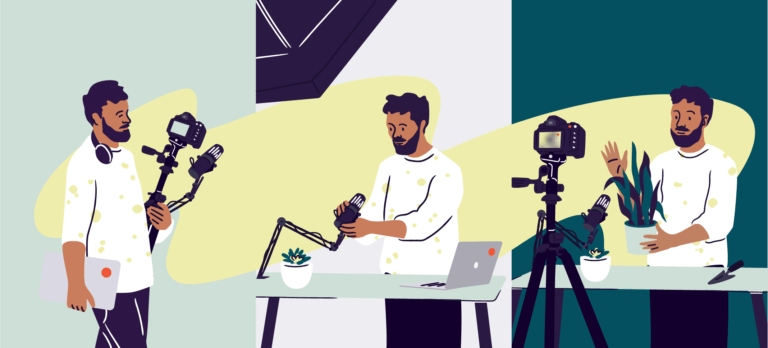We’ve all sat through tedious talks, with text-heavy slides and presenters reciting exactly what’s on the screen. Thankfully, there may be a closing slide in sight. New developments in event technology are changing the way we present, providing innovative ways to grab audiences’ attention and convey information.
This is great news for event creators. The more dynamic and interesting your presentation is, the greater your audience engagement will be. From virtual reality to screen-sharing, we’ve rounded up some of the best new technology presentation trends that are shaking things up.
1. Immerse your audience in another world with VR and AR
For an exciting, innovative way to share your vision, virtual reality (VR) and augmented reality (AR) presentation software is worth looking into. The VR and AR market is expected to add £62.5 billion to the UK economy by 2030. So, it’s no surprise that headsets are expected to become increasingly common in presentation settings.
With a VR presentation simulator, the potential is limitless. VR headsets allow audiences to be transported beyond the screen and into presentations with the presenter. Audiences now get the chance to be immersed in a 360-degree video or to explore interactive data visualisations. With a virtual presentation such as this, the presenter doesn’t even need to be in the same room and can even be transformed into a character within the virtual world.
Meanwhile, AR viewers, like Microsoft’s HoloLens, allow digital content to be overlaid onto the real world. In a presentation scenario, AR headsets worn by audience members can allow the surrounding space to be used as one big canvas. In practice, this could see the walls of a room being used to display information.
2. Demonstrate products in 3D
Another engaging way to present information is by embedding 3D models. They’ve been used for years, but are becoming increasingly popular as the technology becomes more accessible.
PowerPoint’s 3D presentation functionality can allow presenters to, for example, present the engine model of a new car at a trade fair. With a 3D animation of the engine on screen, the presenter is able to rotate, spin, and zoom in and out to show the product from all perspectives. By seeing a product demonstrated in this way, event attendees are more likely to have a better understanding of its design and functionality.
3. Add to your presenting toolkit
Good presentations aren’t just about the information, but how it’s shown. Leap Motion controllers track the movement of hands and fingers, converting them into 3D inputs that can advance slides or zoom in and out. There are also devices such as the Myo armband, which allow presenters to control transitions between slides, digital pointers, and zooming functionality using muscle movements in their arms. (Good news for hosts, since they no longer have to be chained to a lectern.)
You can even be zapped into presentations. Personify Presenter allows users to remove the background from video feeds and overlay themselves onto content as an on-screen presenter. It requires a bit of fancy tech, but can give a unique touch to events and works with a variety of conferencing tools like GoToMeeting and Zoom.
4. Share your screen to enhance engagement
When you find that you need to demonstrate something to your attendees, the quickest and easiest way of achieving this is by sharing your screen. Whether it’s to show your audience the live results of a poll, a walk-through of software, or the workings of a diagram, sharing your screen can help to show exactly what is being explained. Screen-sharing presentation software like Glisser makes it a hassle-free process. Maximise engagement by using it alongside other features such as interactive quizzes and real-time word clouds.
5. Use multimedia to make your presentation dynamic
When using advanced presentation software, you’ll naturally want to make the most out of all of its features. If you have a lot of complex data to present, find ways to make it as visually appealing and digestible as you can using interactive maps, charts, and infographics. You can also add animated GIFs and videos that will capture your audience’s attention. The more movement and life you put into your presentation, the more likely it is that your audience will engage with the content.
Prezi is just one fantastic platform for creating dynamic presentations. Whether it’s the function that allows you to zoom in on critical information, the freedom to navigate anywhere within the presentation, or the ability to present over video alongside your content, there are a ton of features to explore.
6. Mix it up with devices
We’re beginning to see the use of multiple devices for displaying presentations, and giving tablets to event attendees is a brilliant way to increase engagement. When audience members look between a device and the presenter, it gives them a greater degree of control, helping to hold their interest.
Zeetings takes the multiple device approach to another level. Audience members can follow a presentation on computers, tablets, or smartphones from within the presentation room or remotely. As well as watching the presenter, they can also contribute to polls and live Q&As, discuss the presentation amongst themselves in a live feed, and take private notes.
In fact, smartphone presentations mean that you can now present from anywhere. The emergence of pocket-sized projectors and miniature projectors integrated into phones allows you to present on the go, wherever there’s a surface to project on.
It comes down to engagement
When you present, maintaining a good rapport with your audience is key – from body language to eye contact. Whether it’s apps or AR, event technology is constantly giving creators new ways to connect with attendees. Discover more ways to engage virtual audiences and stand out from the competition.




